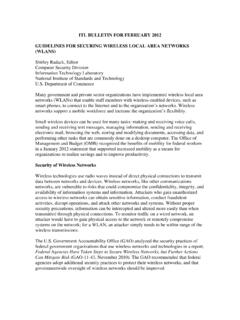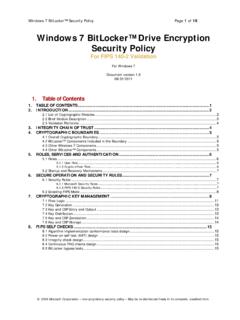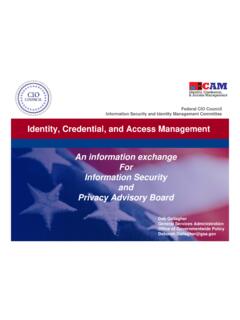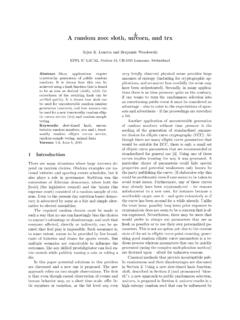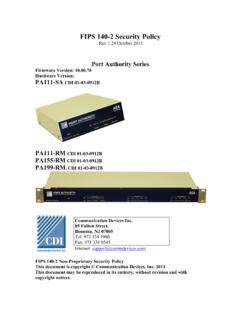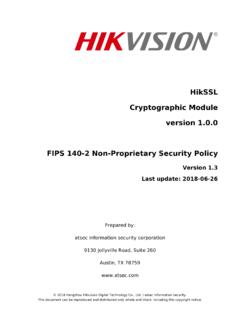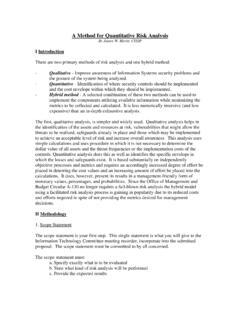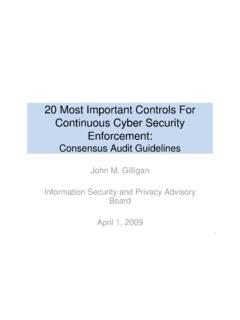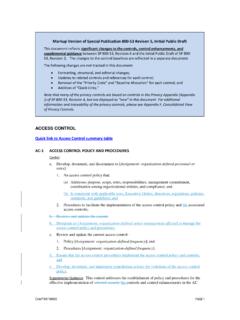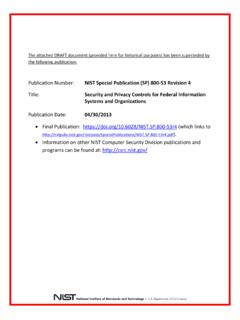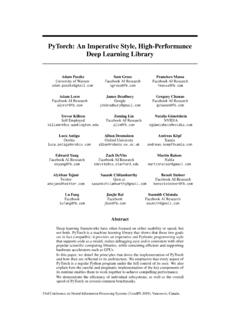Transcription of Security Considerations for Code Signing - NIST
1 NIST Cybersecurity White paper Security Considerations for code Signing David Cooper Andrew Regenscheid Murugiah Souppaya Computer Security Division Information Technology Laboratory Christopher Bean Mike Boyle Dorothy Cooley Michael Jenkins National Security Agency Ft. George G. Meade, Maryland January 26, 2018 ii Abstract A wide range of software products (also known as code ) including firmware, operating systems, mobile applications, and application container images must be distributed and updated in a secure and automatic way to prevent forgery and tampering. Digitally Signing code provides both data integrity to prove that the code was not modified, and source authentication to identify who signed the code . This paper describes features and architectural relationships of typical code Signing solutions that are widely deployed today. It defines code Signing use cases and identifies some Security problems that can arise when applying code Signing solutions to those use cases.
2 Finally, it provides recommendations for avoiding those problems and resources for more information. Keywords application container; code Signing ; digital signature; firmware; mobile application; operating system; software update Acknowledgements The authors wish to thank their colleagues who reviewed drafts of this document and contributed to its technical content during its development. In particular, we wish to thank Docker, HP Inc., Intel Corporation and Microsoft for providing feedback, which was incorporated in this whitepaper. Disclaimer Any mention of commercial products or reference to commercial organizations is for information only; it does not imply recommendation or endorsement by NIST, nor does it imply that the products mentioned are necessarily the best available for the purpose. Additional Information For additional information on NIST s Cybersecurity programs, projects and publications, visit the Computer Security Resource Center, Information on other efforts at NIST and in the Information Technology Laboratory (ITL) is available at and Feedback Feedback on this publication is welcome, and can be sent to: NIST CYBERSECURITY WHITE paper Security Considerations FOR code Signing 1 1 Introduction Recent Security -related incidents indicate the need for a secure software supply chain to protect software products (also referred to as code ) during the development, build, distribution, and maintenance phases.
3 Of particular concern is provisioning and updating software that plays a critical role in platform Security . A wide range of software products, including firmware, operating systems, mobile applications, and application container images must be distributed and updated in a secure and automatic way to prevent forgery and tampering. An effective and common method of protecting software is to apply a digital signature to the code . Digitally Signing code provides both data integrity to prove that the code was not modified, and source authentication to identify who was in control of the code at the time it was signed. When the recipient verifies the signature, he is assured that the code came from the source that signed it, and that it has not been modified in transit. This white paper targets software developers and product vendors who are implementing a code Signing system or reviewing the Security of an existing system, with the goal of achieving improved Security and customer confidence in code authenticity and integrity.
4 System integrators and administrators who are concerned about the trustworthiness of the applications that are installed and run on their systems will learn the properties they should expect from a code Signing solution to protect their software supply chain. This white paper describes features and architectural relationships of typical code Signing solutions that are widely deployed today. It defines code Signing use cases and identifies some Security problems that can arise when applying code Signing solutions to those use cases. Finally, it provides recommendations for avoiding those problems, and resources for more information. Properly applied, these recommendations will help to ensure that the software supply chain is resistant to attack. NIST plans to develop further guidance to help organizations evaluating, deploying or managing code Signing systems. The high-level recommendations described in this document are expected to form the basis for more detailed recommended practices for code Signing .
5 NIST CYBERSECURITY WHITE paper Security Considerations FOR code Signing 2 2 The Basics of code Signing This section provides high-level technical details about how this process works. There are multiple roles in the process: developer, signer, and verifier. The developer is the entity responsible for writing, building, and/or submitting the code that will be signed. This entity maintains a secure development environment, including the source code repository, and will submit code to the signer after it has completed the organization s software development and testing processes. The signer is the entity responsible for managing the keys used to sign software. This role may be performed by the same organization that developed or built the software, or by an independent party in a position to vouch for the source of the code . The signer generates the code Signing private/public key pair on a device that is sufficiently protected, as the Security of this process relies upon the protection of the private key.
6 In many cases, the signer then provides the public key to a certification authority (CA) through a certificate Signing request. The CA will confirm the signer s identity and provides a signed certificate that ties the signer to the provided public key. Anyone can use the public key associated with this certificate to validate the authenticity and integrity of code signed with this key pair. If no CA is used, the public key must instead be distributed using a trusted, out-of-band mechanism. The signer ensures through technical and procedural controls that only authorized code is signed. When code is submitted by developers for Signing , the signer verifies their identities and their authority to request a signature. The signer may also take additional steps to verify the code is trustworthy. Ultimately, two or more trusted agents of the code Signing system may be needed to approve the request and generate a digital signature.
7 In some cases, the signed code may also be provided to a time stamp authority to indicate when the code was signed. The verifier is responsible for validating signatures on signed code . The verifier may be a software component provided by the same developer as the signed code ( , for a signed firmware update), or it may be a shared component provided by the platform ( , the operating system). NIST CYBERSECURITY WHITE paper Security Considerations FOR code Signing 3 3 Architectural Components The code Signing architecture is composed of a set of logical components that are responsible for different aspects of the code Signing process. The code Signing /verifying architecture represented in Figure 1 potentially has four distinct components: the code Signing system (CSS), the certification authority (CA), the time stamp authority (TSA), and the verifier(s). code Signing System (CSS) The first component, the CSS, receives code submitted for Signing , authenticates and authorizes the submitter, and generates the signature.
8 To generate these signatures the CSS has one or more private Signing keys, which need to be carefully protected from extraction or unauthorized use. Certification Authority (CA) Typically, a CSS utilizes a CA to enable authenticating the identities of signers. CAs issue certificates to signers in accordance with certificate policies, which specify the Security controls and practices the CA follows when issuing certificates, and impose requirements on the subjects of the certificates. NIST Interagency Report 7924 [1] is a reference certificate policy that specifies most of the requirements for a CA that issues code Signing certificates. There are also industry groups, such as the CA/Browser Forum [3] and the CA Security Council [4], that have published requirements documents for the issuance of code Signing certificates. code Signing System (CSS) Verifier Certification Authority (CA) Time Stamp Authority (TSA) code Signing Audit logs Verifier Verifier Signed code Figure 1: code Signing Architecture Identification & Authorization NIST CYBERSECURITY WHITE paper Security Considerations FOR code Signing 4 Time Stamp Authority (TSA) Some code Signing architectures use a TSA to demonstrate when a particular piece of code was signed.
9 When a TSA is used, signatures are sent to the TSA, which applies its own signature and Signing time to the package. The TSA operates independently from the CSS and keeps its clock synchronized to an authoritative time source. This allows an entity verifying code to accept the signature on the code as valid if the Signing key was valid at the time the code was signed, even if the key has already expired at the time of verification or the key was compromised sometime after the code was signed. Verifiers Verifiers are responsible for validating the signature and any certificates and time stamps used by the signers. The verifiers also manage any trust anchors that are used to validate certificates. Either the signer or an independent party may be responsible for the verification component. Trust Anchors A critical aspect of managing the verification component is the management of trust anchors that are used to validate signatures, usually by verifying code Signing certificates.
10 Trust anchors are data objects, generally public keys, that are installed and securely stored on the verifying platform. The trustworthiness of a trust anchor is based on the method of its installation, storage and management. Trust anchors are generally not used to verify code directly, but are typically public keys of root CAs that sign over certificates of code - Signing -CAs. This provides a means to recover from incidents resulting in the theft of loss of a private key owned by individual code - Signing -CAs or code signers. While trust anchors must be stored in a protected manner, it is not advisable that trust anchors be permanent - if the corresponding private key were compromised, this would render the platform vulnerable without a means to remediate that vulnerability. NIST CYBERSECURITY WHITE paper Security Considerations FOR code Signing 5 4 code Signing Use Cases The organization establishes a policy that defines the developer(s) authorized to submit code to be signed by the CSS at particular stages of development.
